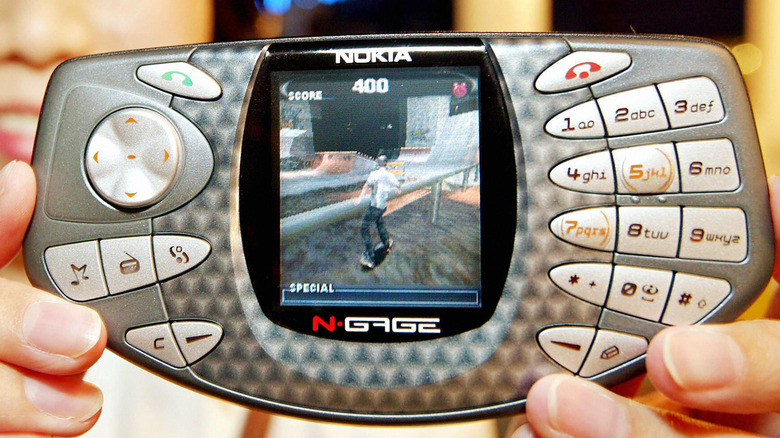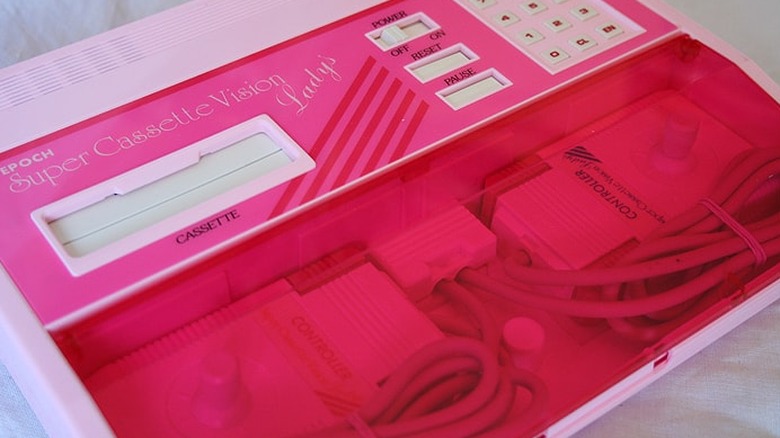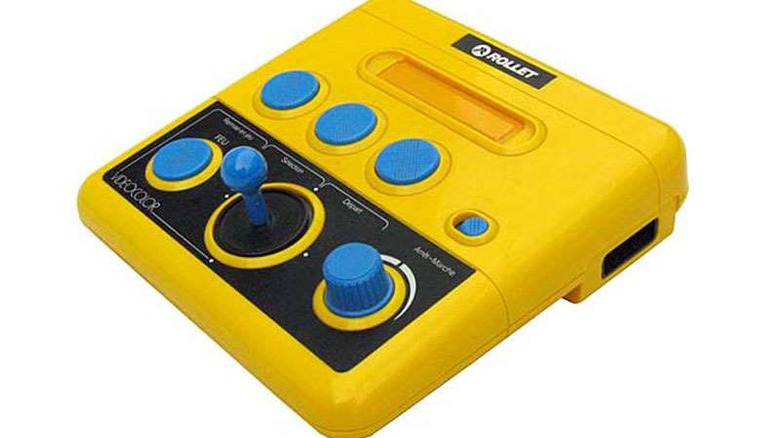The Most Bizarre Console Flops In Gaming History
In recent years, just three companies–Sony, Microsoft, and Nintendo–have dominated the video game hardware market. That makes it easy to forget that dozens of home and handheld video game consoles have actually been released throughout the decades. Since you probably can't name the majority of them, it goes without saying that they weren't all winners, with some flopping in spectacular fashion. While we all know the stories behind the failures of the Sega Dreamcast and the Nintendo Wii U, there are plenty of other bizarre hardware disasters worth exploring. Such as...
Super Lady Cassette Vision
In 1984, Epoch Co. created a "girl-friendly" pink version of their Nintendo Famicom competitor, the Super Cassette Vision. Called the Super Lady Cassette Vision and sold under the YENO brand, the pink-on-pink console came packaged in its own pink carrying purse and was bundled with a game called Milky Princess.
The case was actually pretty useful, too, as it featured plenty of room for the required cables and games — of which the console had 30. Only 16 games were ever released in Europe, however, including Ton Ton Ball, Star Speeder, Kung Fu Road, Miner 2049er, Wheelie Racer, Punchy Boy, Super Golf, and two Astro Wars titles.
Sadly, the pink-colored console for ladies never made it to the United States. Rather, the Japanese-manufactured flop was unsuccessfully marketed in Europe, where it ultimately lost out to Nintendo. France was the only European country even remotely interested in it, but not in numbers remarkable enough to...well...remark upon.
Unsurprisingly, once Nintendo firmly established itself as the dominant console manufacturer in Japan with the previous year's release of the Famicom, Epoch resigned itself to other pursuits — namely, its Doraemon toys and Sylvanian Families line of anthropomorphic animal figurines. As a result, girl gamers have been stuck playing on unisex consoles ever since...though they probably haven't actually noticed.
N-Gage
Before the iPhone, gaming on the go was largely limited to either playing one of Nintendo's handhelds or playing snake on your old Nokia cellphone. The latter company boldly attempted to combine those two mobile technologies in 2003...but the world wasn't quite ready for it.
Enter the Nokia N-Gage, a Game Boy Advance-shaped mobile phone aimed squarely at putting handheld gaming in the pockets of cellphone users everywhere. On paper, it made a lot of sense. In practice, however, it failed to impress, with poor reviews, a less-than-stellar game selection, and a price-tag not too far removed from one of today's iPhones, putting both gamers and phone users off.
The N-Gage didn't help itself much, either. In order to switch out N-Gage games, users had to turn off the phone, take off the device's back cover, remove the battery, swap out the game cartridge, put the battery back in, and reassemble the unit — not exactly user-friendly. As a phone, things weren't much better. Holding the thing up to your face while making a call was awkward, leading to the device receiving the notorious nickname of "Taco Phone."
The N-Gage managed to sell three million units, though that was only half of the company's projected sales.
Virtual Boy
Long before the Oculus Rift, HTC Vive, and PlayStation VR provided a proper entry point into virtual reality gaming, Nintendo gave it a shot — and the results are hard to look at. Literally.
Nintendo's Virtual Boy debuted in America on August 21, 1995, but sales figures were dismal. The unit consisted of a red, stereoscopic 3D display perched atop some stilts, and didn't really immerse users in virtual reality. And while the machine did a pretty decent job of presenting a three-dimensional playing field, it could only do so in red and black, making for some serious eye strain and headaches. That level of physical discomfort cost you, too, with the machine retailing for a whopping $180.
With only 14 games for consumers to choose from, and the Nintendo 64 in development, the Virtual Boy was quickly taken out back and shot, a mere six months after it appeared.
Rollet Videocolor
Looking like something out of Spongebob Squarepants — or even a bit like Spongebob himself — the Rollet Videocolor certainly wins the award for being the most yellow video game console of all time.
Released in Asia in 1983, the Rollet Videocolor featured nearly-identical internal specifications to the Hanimex HMG-7900. On the exterior, however, the two systems looked nothing alike, with the Videocolor opting to burn retinas in a cheap-looking bright yellow and blue shell. Of course, the cheap-exterior only served to accurately reflect the quality of the machine itself, which played simplistic, low-range titles. The Hong Kong-originating console was primarily marketed to children, and all of the controls were housed on the unit itself.
Only 11 games were ever released for the yellow wonder — including Missile Command and Breakout — and the undeniably ugly console fittingly came packed with the equally yellow Pac-Man...though it was pretty much the crappiest Pac-Man ever and looked almost nothing like the pellet gobbler you're used to seeing. In fact, the graphics on every game were downright terrible.
If you're a collector of old hardware and are having trouble finding a Rollet Videocolor, just book a trip into space — you should be able to spot one from there.
Action Max
Once upon a time — in 1987, to be exact — somebody thought it was a good idea to market VCRs as video game consoles.
Created by Worlds of Wonder — the original distributor of Nintendo Entertainment Systems in the United States — the Action Max utilized pre-recorded VHS tapes to create the most one-sided 'interactive experience' ever. Basically, you connected the Action Max to your VCR, stuck a suction-cup sensor on your TV, and, using a glorified light gun, fired away at pre-recorded airplanes or ghosts, with nothing actually happening other than a hit counter registering your successful shots. Fun, right?
Care to give it another go? Just rewind the tape, and try to beat your high score...which shouldn't be that hard, considering the enemies are guaranteed to be in the exact same place at the exact same time — every time. In fact, you didn't even need to do anything to play the Action Max. You could just sit back and watch the video. Now that's gameplay!
While outlandish in hindsight, taking a stab at reconciling the most popular home-video format of the time with video games made a lot of sense. Everybody had VHS tapes, right? Thus, VHS is a format anybody can understand, so the marketability of gaming via VHS seemed like a no brainer...until, you know, you factor in the actual "gaming" part.
R-Zone
Tiger's R-Zone series of handheld consoles flopped in spectacular fashion. Instead of featuring a screen in the unit itself, each game cartridge featured its own LCD screen, which the console would shine light through. The game's visuals were then reflected off a mirror directly into the user's optic stems...often to uncomfortable effect.
The R-Zone was released in three iterations. First came the XPG: Xtreme Pocket Gear, a not-exactly-pocket-sized handheld featuring a flip-up mirror, in 1995. Two years later, Tiger released a table-top model called the Super Screen with a larger, more eye-friendly backlit screen viewable — for the first time — by multiple people. In between, however, Tiger released the most infamous model: the Head Gear.
None of the three models succeeded, and reviews were largely negative. "R-Zone, huh?" wrote The Chicago Tribune's David Jones in 1995." If you ask me it's more like the D-Zone. D for dead. The R-Zone is a waste of time and money...The R-Zone should be dumped into the trash can where it belongs. You'll be better off buying candy and baseball cards with your extra money." Which is exactly what most people did.
View-Master Interactive Vision
The View-Master Interactive Vision — yes, that View-Master — was a game console from 1989 that tried to pretend pre-recorded videotapes were video games, even though Worlds of Wonders' Action Max had already failed at it a couple years before. This time, however, the View-Master Interactive Vision aimed primarily to educate young children. Like the Action Max before it, however, it was a massive flop.
The Interactive Vision itself looked strange and monstrous — as if somebody awkwardly jammed a square plane into a giant, ugly LEGO, attached a fishing pole to it, and then glued on a handful of M&Ms. The game library wasn't much better. The slate of educational "games" numbered in the single digits and was almost entirely comprised of Sesame Street titles, with the occasional Muppet or Disney game to add a bit of non-variety. There also wasn't much gameplay to speak of, aside from occasionally choosing which noise reel to play or making decisions between two choices. As was the case with the Action Max, you could pretty much just sit back and watch the tapes unfold.
These days, View-Master is out of the console game and focusing on their true domain: virtual reality.
Gizmondo
Perhaps the most bizarre flop story in the history of console gaming, home or handheld, is that of the Gizmondo — the self-proclaimed "most advanced handheld gaming console you've ever seen...On steroids."
Tiger Telematics launched its ill-fated handheld — meant to rival the Sony PlayStation Portable and Nintendo DS — in March 2005. In addition to purportedly powering an excellent library of games, Gizmondo was supposed to play videos, take photos, allow you to text your friends, and run GPS applications. Additionally, some games in development supported augmented reality, GPS-functionality, and wireless Bluetooth multiplayer connectivity. Sounds pretty awesome, right?
Unfortunately, nothing about the Gizmondo was awesome. It came priced at a whopping $400. The screen was severely undersized when compared to Sony's PSP. And only eight games were ever released in the U.S. Assuming you could find one of the specialized kiosks selling the Gizmondo's games in your local mall, you were treated to downright awful versions of games like SSX 3 and FIFA Football 2005.
A year after launch, Tiger Telematics filed for bankruptcy, having lost £189 million. Around the same time, Gizmondo executive Stefan Eriksson wrecked his Ferrari Enzo while speeding along at 162 miles per hour, and was later jailed for illegally importing the extravagant automobile. Of course, illegal activities were nothing new to Eriksson, who was well-connected to the Swedish mafia group Uppsalamaffian.
HyperScan
Once again taking a stab at the home-console market, Mattel launched their HyperScan — a home console with a 13.56 MHz RFID scanner — in 2006. From a marketability standpoint, the console was pure genius. How could you go wrong by combining the addictive nature of card collecting with the awesomeness of video games? Mattel found a way.
Though not the most uninteresting gimmick in the world — proven by Nintendo's similar concept for their highly-successful Amiibos — the HyperScan's main attraction, the RFID-card reader, was unreliable at best. Cards often took upwards of two minutes to scan in properly, and once you got your character all scanned in, matters were made worse by the fact that you were then forced to play on hardware that had been rendered obsolete before much of the $69.99 machine's target audience was even born.
Though the HyperScan was a novel idea, the subpar execution ultimately rendered the console little more than a cheap piece of gaming garbage. Its sound was atrocious, its graphics were hideous, load-times were mind-numbing, and the controllers were anything but ergonomic. Only five games ever saw the light of day, and the HyperScan was discontinued the year after it released.
Coleco Telstar Arcade
Released in time to take up the vast majority of space under your Christmas tree in 1977, the Telstar Arcade was the final iteration of Coleco's Telstar lineup of home consoles.
The Telestar Arcade was a pyramid of power, featuring traditional pong controls on one face, a light gun on the other, and a steering wheel on the third. Even the game cartridges were triangular and allowed for some fancy (at the time) color video. The beastly system came with a pack-in cartridge which, like the other three cartridges released, held three games.
Only four cartridges were ever produced for the system, and were priced at $25 a pop. The entire game library was comprised of Road Race, Tennis, Quick Draw, Hockey, Tennis, Handball, Target, Pinball, Shooting Gallery, Shoot the Bear, Naval Battle, Speed Ball, and Blast-Away — making the entire lineup comparable to that on Telstar Arcade's competitor, the Atari 2600.
Though an undeniably awesome machine for its time, the Telstar Arcade ultimately couldn't compete with the likes of the Mattel Intellivision, Atari VCS and Magnavox Odyssey 2. The Telstar Arcade was quickly abandoned, and Coleco moved on to their more powerful ColecoVision.



